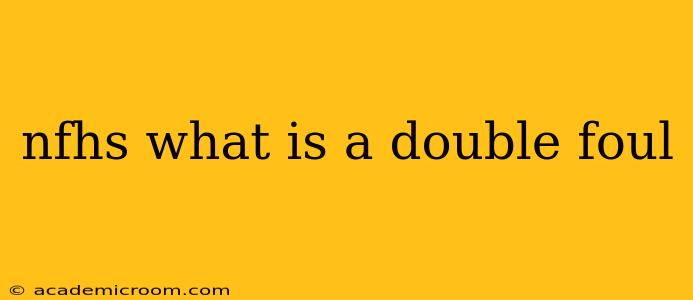In the world of high school sports governed by the National Federation of State High School Associations (NFHS), understanding the rules is crucial for players, coaches, and officials alike. One frequently debated rule is the double foul. This article delves into the intricacies of NFHS double fouls, explaining what constitutes one, its implications on the game, and answers some frequently asked questions.
What is a Double Foul in NFHS?
A double foul in NFHS basketball occurs when two opposing players commit fouls against each other simultaneously, or in such close proximity and sequence that they are considered to have happened at the same time. It's important to note that the fouls don't need to be identical; one player could commit a charging foul while the other commits a blocking foul, and a double foul would still be called. The key is the near-simultaneity and mutual involvement. The officials must judge the situation based on their assessment of the actions and timing.
The intent behind calling a double foul is to neutralize the infraction, preventing one team from gaining an unfair advantage due to simultaneous fouls. Think of it as a simultaneous, mutual mistake, preventing an advantage to either side.
How is a Double Foul Called?
The officiating crew uses their judgment to determine if a double foul has occurred. They consider several factors:
- Timing: Were the fouls virtually simultaneous?
- Proximity: Did the fouls occur in close proximity to each other?
- Mutual Involvement: Were both players directly involved in the action resulting in the fouls?
The officials will signal a double foul with the appropriate hand signals, typically indicating the fouls to both teams. No free throws are awarded, and possession remains with the team that had possession before the fouls.
What Happens After a Double Foul is Called?
The consequences of a double foul are relatively straightforward:
- No free throws: Neither team shoots free throws.
- No possession change: The team that had possession before the double foul retains possession.
- Jump ball (if applicable): In some cases, particularly if the fouls occurred during a jump ball situation, a jump ball may be used to resume play.
This neutralizes the fouls, preventing either team from gaining an unfair advantage.
Is there a Difference Between a Double Foul and Two Separate Fouls?
Yes, there is a crucial difference. Two separate fouls involve two separate actions, one by each player, not occurring at roughly the same time. These fouls are called individually, and the appropriate penalties are assessed according to the nature of each foul. For example, if Player A commits a flagrant foul, and Player B commits a common foul immediately after but unrelatedly, these are assessed as two separate fouls.
Can a Double Foul Result in Technical Fouls?
While rare, a double foul could lead to technical fouls if the actions of the players involved warrant such calls. For instance, if both players engage in unsportsmanlike conduct alongside the fouls, technical fouls might be added to the double foul call. However, a double foul itself doesn't automatically trigger technical fouls.
How are Double Fouls Judged in Different Sports?
While the concept of a double foul is common in sports with player-to-player contact, such as basketball, the exact rules and application might differ slightly across sports governed by different rule sets. Always refer to the specific rule book of the governing body for the particular sport you're watching or playing.
Understanding double fouls in NFHS basketball requires careful observation of the interplay between simultaneous actions, proximity, and the officials' judgment. This nuanced rule ensures fairness and prevents one team from unfairly benefiting from a situation where both teams commit infractions almost simultaneously. Remember, if in doubt, consult the official NFHS rule book for the most precise and updated information.
